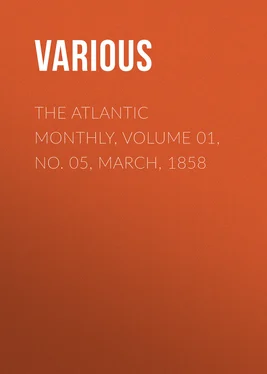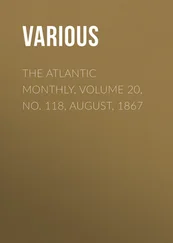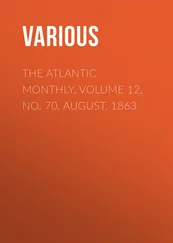Various - The Atlantic Monthly, Volume 01, No. 05, March, 1858
Здесь есть возможность читать онлайн «Various - The Atlantic Monthly, Volume 01, No. 05, March, 1858» — ознакомительный отрывок электронной книги совершенно бесплатно, а после прочтения отрывка купить полную версию. В некоторых случаях можно слушать аудио, скачать через торрент в формате fb2 и присутствует краткое содержание. Жанр: foreign_antique, periodic, foreign_edu, на английском языке. Описание произведения, (предисловие) а так же отзывы посетителей доступны на портале библиотеки ЛибКат.
- Название:The Atlantic Monthly, Volume 01, No. 05, March, 1858
- Автор:
- Жанр:
- Год:неизвестен
- ISBN:нет данных
- Рейтинг книги:4 / 5. Голосов: 1
-
Избранное:Добавить в избранное
- Отзывы:
-
Ваша оценка:
- 80
- 1
- 2
- 3
- 4
- 5
The Atlantic Monthly, Volume 01, No. 05, March, 1858: краткое содержание, описание и аннотация
Предлагаем к чтению аннотацию, описание, краткое содержание или предисловие (зависит от того, что написал сам автор книги «The Atlantic Monthly, Volume 01, No. 05, March, 1858»). Если вы не нашли необходимую информацию о книге — напишите в комментариях, мы постараемся отыскать её.
The Atlantic Monthly, Volume 01, No. 05, March, 1858 — читать онлайн ознакомительный отрывок
Ниже представлен текст книги, разбитый по страницам. Система сохранения места последней прочитанной страницы, позволяет с удобством читать онлайн бесплатно книгу «The Atlantic Monthly, Volume 01, No. 05, March, 1858», без необходимости каждый раз заново искать на чём Вы остановились. Поставьте закладку, и сможете в любой момент перейти на страницу, на которой закончили чтение.
Интервал:
Закладка:
Various
The Atlantic Monthly, Volume 01, No. 05, March, 1858 / A Magazine of Literature, Art, and Politics
THE CATACOMBS OF ROME
—–parti elette Di Roma, che son state cimitero Alla milizia che Pietro seguette.
PARADISO, c. ix."Roma Sotterranea,"—the underground Rome of the dead,—the buried city of graves. Sacred is the dust of its narrow streets. Blessed were those who, having died for their faith, were laid to rest in its chambers. In pace is the epitaph that marks the places where they lie. In pace is the inscription which the imagination reads over the entrance to the Christian Catacombs.
Full as the upper city is of great and precious memories, it possesses none greater and more precious than those which belong to the city under ground. Republican Rome had no braver heroes than Christian Rome. The ground and motives of action were changed, but the courage and devotion of earlier times did not surpass the courage and devotion of later days,—while a new spirit displayed itself in new and unexampled deeds, and a new and brighter glory shone from them over the world. But, unhappily, the stories of the early Christian centuries were taken possession of by a Church which has sought in them the means of enhancing her claims and increasing her power; mingling with them falsehoods and absurdities, cherishing the wildest and most unnatural traditions, inventing fictitious miracles, dogmatizing on false assertions, until reasonable and thoughtful religious men have turned away from the history of the first Christians in Rome with a sensation of disgust, and with despair at the apparently inextricable confusion of fact and fable concerning them.
But within a few years the period to which these stories belong has begun to be investigated with a new spirit, even at Rome itself, and in the bosom of the Roman Church. It was no unreasonable expectation, that, from a faithful and honest exploration of the catacombs, and examination of the inscriptions and works of art in them or derived from them, more light might be thrown upon the character, the faith, the feeling, and the life of the early Christians at Rome, than from any other source whatever. Results of unexpected interest have proved the justness of this expectation.
These results are chiefly due to the labors of two Romans, one a priest and the other a layman, the Padre Marchi, and the Cavaliere de Rossi, who have devoted themselves with the utmost zeal and with great ability to the task of exploration. The present Pope, stimulated by the efforts of these scholars, established some years since a Commission of Sacred Archeology for the express purpose of forwarding the investigations in the catacombs; and the French government, soon after its military occupation of Rome, likewise established a commission for the purpose of conducting independent investigations in the same field. 1 1 In 1844, Padre Marchi published a series of numbers, seventeen in all, of a work entitled Monumenti delle Arti Cristiane Primitive nella Metropol del Cristianesmo . The numbers are in quarto, and illustrated by many carefully executed plates. The work was never completed; but it contains a vast amount of important information, chiefly the result of Padre Marchi's own inquiries. The Cavaliere de Rossi, still a young man, one of the most learned and accomplished scholars of Italy, is engaged at present in editing all the Christian inscriptions of the first six centuries. No part of this work has yet appeared. He is the highest living authority on any question regarding the catacombs. The work of the French Commission has been published at Paris in the most magnificent style, in six imperial folio volumes, under the title, Catacombes de Rome , etc., etc. Par LOUIS PERRET. Ouvrage publié par Ordre et aux Frais du Gouvernement, sous la Direction d'une Commission composée de MM. AMPERE, INGRES, MERIMÉE, VITET. It consists of four volumes of elaborate colored plates of architecture, mural paintings, and all works of art found in the catacombs, with one volume of inscriptions, reduced in fac-simile from the originals, and one volume of text. The work is of especial value as regards the first period of Christian Art. Its chief defect is the want of entire accuracy, in some instances, in its representations of the mural paintings,—some outlines effaced in the original being filled out in the copy, and some colors rendered too brightly. But notwithstanding this defect, it is of first importance in illustrating the hitherto very obscure history and character of early Christian Art.
The Roman catacombs consist for the most part of a subterranean labyrinth of passages, cut through the soft volcanic rock of the Campagna, so narrow as rarely to admit of two persons walking abreast easily, but here and there on either side opening into chambers of varying size and form. The walls of the passages, through their whole extent, are lined with narrow excavations, one above another, large enough to admit of a body being placed in each; and where they remain in their original condition, these excavations are closed in front by tiles, or by a slab of marble cemented to the rock, and in most cases bearing an inscription. Nor is the labyrinth composed of passages upon a single level only; frequently there are several stories, connected with each other by sloping ways.
There is no single circumstance, in relation to the catacombs, of more striking and at first sight perplexing character than their vast extent. About twenty different catacombs are now known and are more or less open,—and a year is now hardly likely to pass without the discovery of a new one; for the original number of underground cemeteries, as ascertained from the early authorities, was nearly, if not quite, three times this number. It is but a very few years since the entrance to the famous catacomb of St. Callixtus, one of the most interesting of all, was found by the Cavaliere de Rossi; and it was only in the spring of 1855 that the buried church and catacomb of St. Alexander on the Nomentan Way were brought to light. Earthquakes, floods, and neglect have obliterated the openings of many of these ancient cemeteries,—and the hollow soil of the Campagna is full "of hidden graves, which men walk over without knowing where they are."
Each of the twelve great highways which ran from the gates of Rome was bordered on either side, at a short distance from the city wall, by the hidden Christian cemeteries. The only one of the catacombs of which even a partial survey has been made is that of St. Agnes, of a portion of which the Padre Marchi published a map in 1845. "It is calculated to contain about an eighth part of that cemetery. The greatest length of the portion thus measured is not more than seven hundred feet, and its greatest width about five hundred and fifty; nevertheless, if we measure all the streets that it contains, their united length scarcely falls short of two English miles. This would give fifteen or sixteen miles for all the streets in the cemetery of St. Agnes." 2 2 The foregoing extract is taken from a book by the Rev. J. Spencer Northcote, called The Roman Catacombs, or some Account of the Burial-Places of the Early Christians in Rome : London, 1857. It is the best accessible manual in English,—the only one with any claims to accuracy, and which contains the results of recent investigations. Mr. Northcote is one of the learned band of converts from Oxford to Rome. A Protestant may question some of the conclusions in his book, but not its general fairness. Our own first introduction to the catacombs, in the winter of 1856, was under Mr. Northcote's guidance, and much of our knowledge of them was gained through him. Mr. Northcote estimates the total length of the catacombs at nine hundred miles; we cannot but think this too high.
Интервал:
Закладка:
Похожие книги на «The Atlantic Monthly, Volume 01, No. 05, March, 1858»
Представляем Вашему вниманию похожие книги на «The Atlantic Monthly, Volume 01, No. 05, March, 1858» списком для выбора. Мы отобрали схожую по названию и смыслу литературу в надежде предоставить читателям больше вариантов отыскать новые, интересные, ещё непрочитанные произведения.
Обсуждение, отзывы о книге «The Atlantic Monthly, Volume 01, No. 05, March, 1858» и просто собственные мнения читателей. Оставьте ваши комментарии, напишите, что Вы думаете о произведении, его смысле или главных героях. Укажите что конкретно понравилось, а что нет, и почему Вы так считаете.












